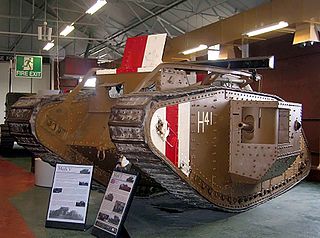
An armoured fighting vehicle or armored fighting vehicle (AFV) is an armed combat vehicle protected by armour, generally combining operational mobility with offensive and defensive capabilities. AFVs can be wheeled or tracked. Examples of AFVs are tanks, armoured cars, assault guns, self-propelled guns, infantry fighting vehicles (IFV), and armoured personnel carriers (APC).

An infantry fighting vehicle (IFV), also known as a mechanized infantry combat vehicle (MICV), is a type of armoured fighting vehicle used to carry infantry into battle and provide direct-fire support. The 1990 Treaty on Conventional Armed Forces in Europe defines an infantry fighting vehicle as "an armoured combat vehicle which is designed and equipped primarily to transport a combat infantry squad, and which is armed with an integral or organic cannon of at least 20 millimeters calibre and sometimes an antitank missile launcher". IFVs often serve both as the principal weapons system and as the mode of transport for a mechanized infantry unit.

The Combat Vehicle 90 (CV90) is a family of Swedish tracked armored combat vehicles designed by the Swedish Defence Materiel Administration (FMV), Hägglunds and Bofors during the mid-1980s to early 1990s, entering service in Sweden in the mid-1990s. The CV90 platform design has continuously evolved from the Mk 0 to current Mk IV with technological advances and changing battlefield requirements. The Swedish version of the main infantry fighting vehicle (IFV) is fitted with a turret from Bofors equipped with a 40 mm Bofors autocannon. Export versions are fitted with Hägglunds E-series turrets, armed with either a 30 mm Mk44 or a 35 mm Bushmaster autocannon.

The Boxer is a multirole armoured fighting vehicle designed by an international consortium to accomplish a number of operations through the use of installable mission modules. The governments participating in the Boxer programme have changed as the programme has developed. The Boxer vehicle is produced by the ARTEC GmbH industrial group, and the programme is being managed by OCCAR. ARTEC GmbH is based in Munich; its parent companies are Krauss-Maffei Wegmann GmbH and Rheinmetall Military Vehicles GmbH on the German side, and Rheinmetall Defence Nederland B.V. for the Netherlands. Overall, Rheinmetall has a 64% stake in the joint venture.
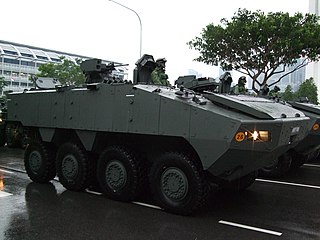
The Terrex Infantry Carrier Vehicle (ICV) is an armoured fighting vehicle (AFV) developed by ST Engineering of Singapore and Timoney Technology of Ireland, and produced by ST Engineering Land Systems for the Singapore Army as well as by Turkish auto-maker Otokar as the Yavuz (AV-82) for the Turkish military.

The Warrior tracked vehicle family is a series of British armoured vehicles, originally developed to replace FV430 series armoured vehicles. The Warrior started life as the MCV-80, "Mechanised Combat Vehicle for the 1980s". One of the requirements of the new vehicle was a top speed able to keep up with the projected new MBT, the MBT-80 – later cancelled and replaced by what became the Challenger 1 – which the FV432 armoured personnel carrier could not. The project was begun in 1972; GKN Defence won the production contract in 1984 and the Warrior was accepted for service with the British Army in November 1984. Production commenced in January 1986 at Telford, with the first vehicles completed in December that year. GKN Defence was purchased by BAE Systems, via Alvis plc.

The Bionix (BX) is a family of tracked Singaporean armoured fighting vehicles developed by ST Kinetics. Intended to augment the Singapore Army's aging M113 armoured personnel carriers, it is the first indigenous armoured vehicle to be developed in Southeast Asia. The Bionix has been operational with the Singapore Armed Forces (SAF) since 1999 in a wide variety of adaptations including the Bionix II, Bionix 25 and Bionix 40/50 variants.

The Bushmaster Protected Mobility Vehicle or Infantry Mobility Vehicle is an Australian-built four-wheel drive armoured vehicle. The Bushmaster was primarily designed by the then government-owned Australian Defence Industries (ADI), and is currently produced by Thales Australia following their acquisition of ADI. The Bushmaster is currently in service with the Australian Army, Royal Australian Air Force, Royal Netherlands Army, British Army, Japan Ground Self Defense Force, Indonesian Army, Fiji Infantry Regiment, Jamaica Defence Force, New Zealand Army and the Armed Forces of Ukraine.

ACV-15 is the designation of an amphibious Infantry fighting vehicle family developed by the Turkish defense company FNSS Savunma Sistemleri A.Ş. This vehicle is also manufactured by DRB-HICOM Defence Technologies (DefTech). The design is an attempt to combine the capabilities of an infantry fighting vehicle (IFV) and an armoured personnel carrier (APC). The ACV-15 is based on the American Advanced Infantry Fighting Vehicle, which in turn is based on the American M113A1 armored personnel carrier.
ST Engineering Land Systems Ltd (STELS), doing business as ST Kinetics, is a strategic business area of ST Engineering and handles land systems and specialty vehicles.

Otokar Otomotiv ve Savunma Sanayi A.Ş., also known simply as Otokar, is a Turkish bus and military vehicle manufacturer headquartered in Sakarya, Turkey. Otokar is a subsidiary of Koç Holding.

The CM-32 "Clouded Leopard", officially Taiwan Infantry Fighting Vehicle (TIFV), is an eight-wheeled armoured vehicle currently being produced for the Taiwanese Army. It is based on the 6x6 CM-31 designed by Timoney Technology Limited of Ireland and is further developed by the Ordnance Readiness Development Center.

Otokar Arma is a 6x6 and 8x8 amphibious wheeled armored combat vehicle family designed and developed by Otokar. The vehicle is a modular multi-wheel configurable with a monocoque steel hull.
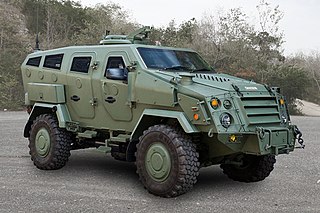
First Win is a mine-resistant ambush protected infantry mobility vehicle with an all-welded steel monocoque V-hull that provides high level protection against a variety of battlefield threats, including mines and improvised explosive devices. Gross vehicle weight is about nine tonnes and it can carry up to 10 troops plus driver.

The Oerlikon KBA is a 25 mm (25×137mm) autocannon, developed as a close range multipurpose weapon for the mechanised battlefield, originally made by Oerlikon and currently produced in Rheinmetall Italia S.p.A. facilities. It is a positively locked breech, gas-operated cannon with a rotating bolt head and a dual-belt selective feed system taking a 25mm NATO cartridge. The rate of fire in burst mode is 600 rounds per minute but it can be adjusted electronically and reduced to single shot or a selectable range from 100 up to 200 rounds per minute.
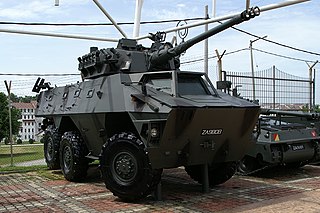
The SIBMAS is a Belgian amphibious infantry fighting vehicle. It was engineered from the same prototype as the South African Ratel. In appearance the vehicle is also similar to the Chinese WZ-523 armoured personnel carrier. The SIBMAS was developed between 1975 and 1976 at a department of the BN Constructions Ferroviaires et Metalliques in Nivelles. Production was on an order-by-order basis and commenced only for the Malaysian Army.

The Hunter Armoured Fighting Vehicle is a tracked Singaporean armoured fighting vehicle jointly developed by ST Engineering, Defence Science and Technology Agency, and the Singapore Army. Intended to replace the Singapore Army's aging Ultra M113 armoured personnel carriers, it was commissioned in 2019. It is the Singapore Army's and the world's first fully digitalised platform, and is designed to provide armoured forces with enhanced capabilities to operate more effectively and efficiently in various phases of military operations. It was formerly known as ST Kinetics Next Generation Armoured Fighting Vehicle (NGAFV).
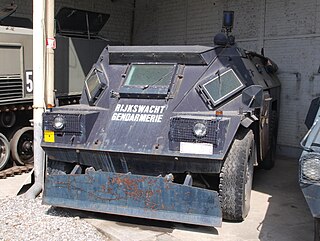
The Timoney armoured personnel carrier refers to a series of armored personnel carriers developed by Timoney Technology Limited of Ireland in the 1970s and 1980s.




















